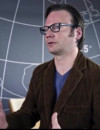UW In The News
-
That Time In The Middle Ages When The Devil Became A Lawyer
Quoted: This might seem like strange territory for a historian of the European Middle Ages but it’s one that’s quite familiar to Prof. Karl Shoemaker from the University of Wisconsin-Madison. His research focus is medieval law, and he says that just this debate – how should the law be applied – was one that people of the period thought about almost constantly.
-
Ultrathin “stealth sheet” can hide and fake heat signatures
Metamaterials that cloak people and objects from radar, visible light or infrared are usually thick and heavy, but now engineers at the University of Wisconsin-Madison have developed an ultrathin, lightweight sheet that absorbs heat signatures and can even present false ones.
-
Vietnam War: Wisconsin student turns paper into book on state’s MIA soldiers
MADISON – A news story posted on Facebook jolted Erin Miller when she read it in 2014.
-
College-money lessons you didn’t learn in high school
Quoted: A spending plan shows how overspending one week will leave you with a cash shortage the next week. Even a $50 shortfall can feel stressful, says J. Michael Collins, faculty director for the Center for Financial Security at University of Wisconsin, Madison.
-
The Supreme Court decided not to decide Wisconsin’s gerrymandering case. But here’s why it will be back.
On Monday, the Supreme Court surprised observers by deciding not to decide Gill v. Whitford, the high-profile case about partisan gerrymandering in Wisconsin. Instead, the court remanded the case back to Wisconsin district court to give the plaintiffs “an opportunity” to provide better evidence about whether they had the right to bring the suit at all.
By Barry Burden and David Canon
-
Military families can teach us about the cost of family separations
Piece co-written by Tova Walsh, an assistant professor of Social Work and Affiliate of the Center for Child and Family Well-Being.
-
Supreme Court faces major decision on partisan gerrymandering
Quoted: Though both cases involve challenges to partisan gerrymandering, Barry Burden, a political science professor and director of the Elections Research Center at the University of Wisconsin-Madison, said the justices could be having a hard time reconciling the different legal theories being argued.
-
Burden: No bright line ruling likely on SCOTUS gerrymandering cases
The U.S. Supreme Court soon may redefine how legislators get elected to office. Two high-profile cases that seek to rein in partisan gerrymandering are slated for decisions by late June. The rulings could be landmarks. But, however the court comes out, the fight against gerrymandering will be far from over.
-
Bees, climate change and Amish children: What do these UW projects have in common?
Studies of bees, climate change and Amish children are among the eight projects out of 70 receiving grants from one of UW-Madison’s largest endowments.
-
Some of Africa’s Biggest Baobab Trees Are Dying Off
Noted: Baobabs, especially old ones, can be more vulnerable to drought than their grizzled appearance might suggest, says David Baum, an ecologist at the University of Wisconsin-Madison. But more evidence is needed, he says, to strengthen the link between climate change and the baobab deaths.
-
Study: In 2016, Wisconsin’s job market improved but the state’s poverty rate increased
Despite a robust job market, Wisconsin’s poverty rate increased to 10.8% in 2016, compared to 9.7% in 2015, according to a report released Friday by researchers at the University of Wisconsin-Madison.
-
Promises on North Korea are easy to make but hard to keep. Here’s why.
The June 12 summit between Donald Trump and Kim Jong Un in Singapore seems back on the calendar. But it’s not likely to result in the peaceful denuclearization of the Korean Peninsula.
Andrew Kydd is a professor in the University of Wisconsin’s department of political science.
-
Earth’s days used to be just 18 hours long, but the Moon changed that
If you’ve ever felt like there just aren’t enough hours in the day just be glad that you didn’t live on Earth 1.4 billion years ago. A new study led by researchers at the University of Wisconsin – Madison reveals that ancient Earth had much shorter days, and the 24-hour days that we experience in modern times come courtesy of the Moon.
-
A day used to be less than 19 hours long 1.4 billion years ago
t’s not just you – the days really are getting longer. More than a billion years ago, the moon used to be about 40,000 kilometres closer, which made Earth spin faster. Back then, the days were less than 19 hours long. (Paywall)
-
The days are getting longer – but very, very slowly
As the Earth’s rotation gradually winds down, the moon moves further away. Writing in Proceedings of the National Academy of Sciences, Stephen Meyers at the University of Wisconsin-Madison and Alberto Malinverno at Columbia University in New York calculate that over the past 1.4bn years the moon has drifted about 44,000km from Earth to a distance of 384,400km
-
Innovative UW researchers win Shaw science awards
Two researchers at UW-Madison have been selected as recipients of the 2018 Shaw Scientist Awards, each getting $200,000 in seed funding to continue their innovative research work.
-
Revealed: Why days on Earth are getting longer
As the moon moves away, the Earth is like a spinning figure skater who slows down as they stretch their arms out, explained Professor Stephen Meyers, professor of geoscience at the University of Wisconsin-Madison.
-
Think days are short now? They once lasted just 18 hours
“As the moon moves away, the Earth is like a spinning figure skater who slows down as they stretch their arms out,” explained Professor Stephen Meyers, of the University of Wisconsin-Madison.
-
No lie-in this morning? Thank the Moon’s gravitational pull
“As the moon moves away, the Earth is like a spinning figure skater who slows down as they stretch their arms out,” said Stephen Meyers, co-author of the study and a geoscience professor at the University of Wisconsin-Madison.
-
Falling short on time? Earth might have 25 hours in a day in the future
The study author of geoscience Stephen Meyers at the University of Wisconsin-Madison explained the relation between Earth’s spin and the location of Moon as that of a spinning figure skater and his arms. The way skater slows down his spinning speed by stretching his arms out, the spinning speed of Earth is slowing down as the moon is distancing itself from the planet.
-
The Moon is causing days on Earth to get longer
Using a new statistical method called astrochronology, astronomers peered into Earth’s deep geologic past and reconstructed the planet’s history. This work revealed that, just 1.4 billion years ago, the moon was significantly closer to Earth, which made the planet spin faster. As a result, a day on Earth lasted just over 18 hours back then, according to a statement from the University of Wisconsin-Madison.
-
Can state force Foxconn to install solar panels for public use?
Quoted: Jack Huddleston, emeritus professor of urban and regional planning at the University of Wisconsin-Madison, said trying to re-open negotiations now would be “pretty risky” for the state.
-
Watch in Real Time as American Airlines 1897 Tries to Escape a Hail Storm From Hell
Noted: Rick Kohrs, a graphic artist at NOAA’s Cooperative Institute for Meteorological Satellite Studies at the University of Wisconsin-Madison, created this image of the plane’s “terrifying track.” He superimposed AA 1897’s flight path from Flight Aware with weather data from GOES-16, the latest sat from the Geostationary Operational Environmental Satellite (GOES) program. These sats capture storms as they develop, giving meteorologists a space-based tool to predict storms and warn people about ones that exist.
-
How the Moon may one day give us 25-hour days
forgets memory cardResearchers from the University of Wisconsin-Madison have worked out that around 1.4 billion years ago, a day on Earth lasted 18 hours. “This is at least in part because the Moon was closer and changed the way the Earth spun around its axis,” the Daily Mirror reports.
-
Map-making on a budget
Shanan Peters, a geologist at the University of Wisconsin–Madison, is the principal investigator on the Macrostrat project, which is an online encyclopaedic atlas for geological data. Although most of the Macrostrat mapping data are publicly available, importing them required “a fair bit of time”, Peters says.
-
Days are longer than they used to be due to moon moving away from earth, study finds
Researchers at the University of Wisconsin-Madison have found that 1.4 billion years ago the moon orbited much closer to the planet, altering the way it spins on its axis.The study also said the moon will continue to move away from Earth, making our days even longer.
-
The Moon Is Making Every Day on Earth Longer Than the Last, Study Shows
The new study, co-authored by Stephen Meyers, Ph.D., a professor of geoscience at the University of Wisconsin-Madison, and Alberto Malinverno, Ph.D., a research professor at Columbia University’s Lamont-Doherty Earth Observatory, isn’t just about the moon. The researchers initially set out to find a way to accurately study the many phases that our planet has undergone since its beginning, both in terms of its geology and its place in the solar system.
-
Wish you had more time in the day? A day on Earth could soon last 25 HOURS – and it’s thanks to the moon
Study author Professor of geoscience Stephen Meyers at the University of Wisconsin-Madison, said: “As the moon moves away, the Earth is like a spinning figure skater who slows down as they stretch their arms out.”
-
Days Are Longer Now Because the Moon Moves Away from Earth (Study)
Once upon a time, when the moon was closer to our planet, a day only had 18 hours. According to the University of Wisconsin-Madison researchers, about 1.4 billion years ago, the moon was orbiting Earth a lot closer than it is now, altering the way it spins on its axis.
-
Moon to give us longer days
Study author Professor of geoscience Stephen Meyers at the University of Wisconsin-Madison, said: “As the moon moves away, the Earth is like a spinning figure skater who slows down as they stretch their arms out.”
- Newer stories
- Page 98 of 143
- Older stories
Featured Experts
John Hall: Illinois and Oregon Intensify Efforts to Block Trump’s Guard Deployments
Hall, a historian of U.S. defense policy and civil-military relations, can discuss the significance of this moment. He notes that… More
Chris Vagasky: The Government Shutdown’s Impact on FEMA and the National Weather Service
Chris Vagasky can discuss how the federal government shutdown affects the operations of the National Weather Service (NWS) and the Federal… More


